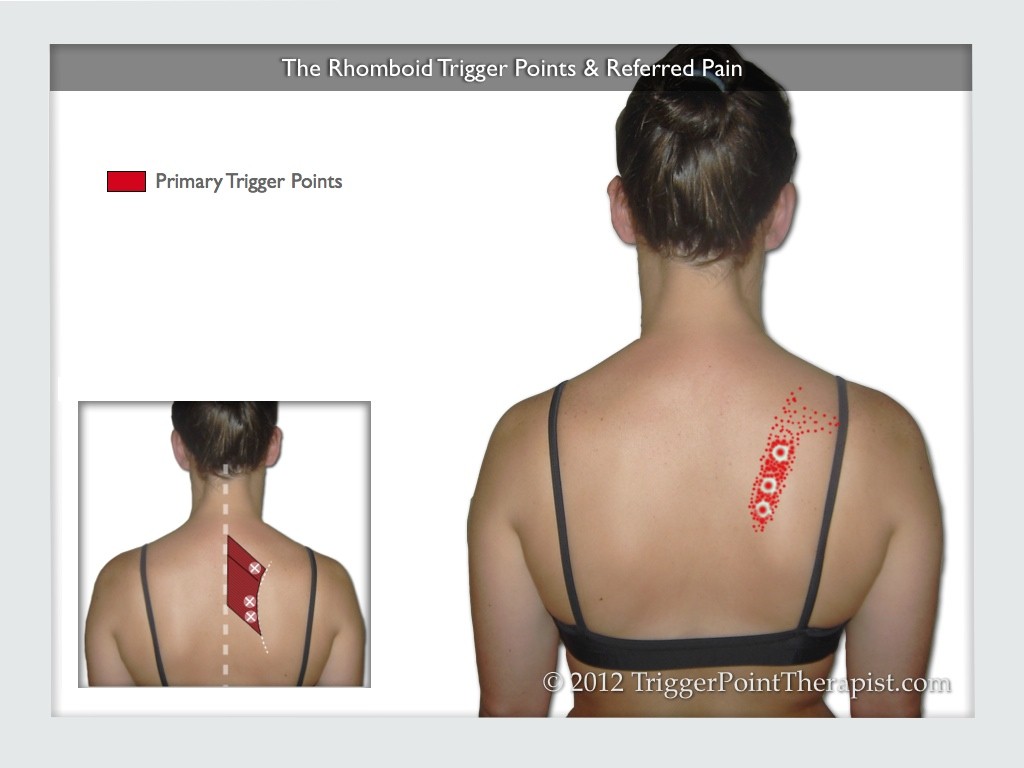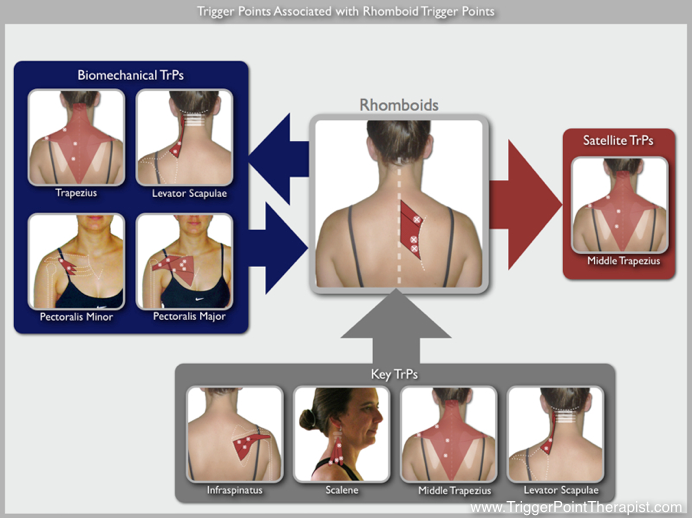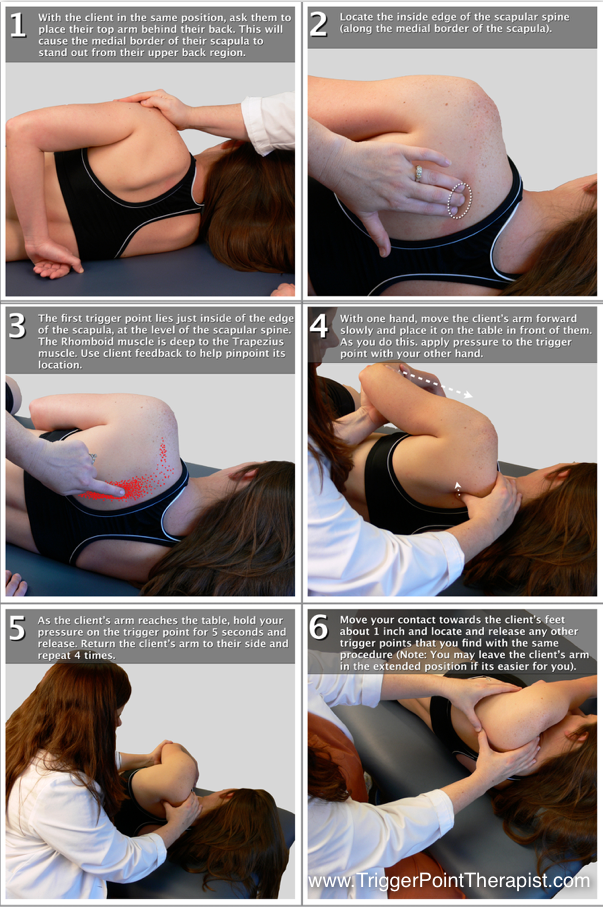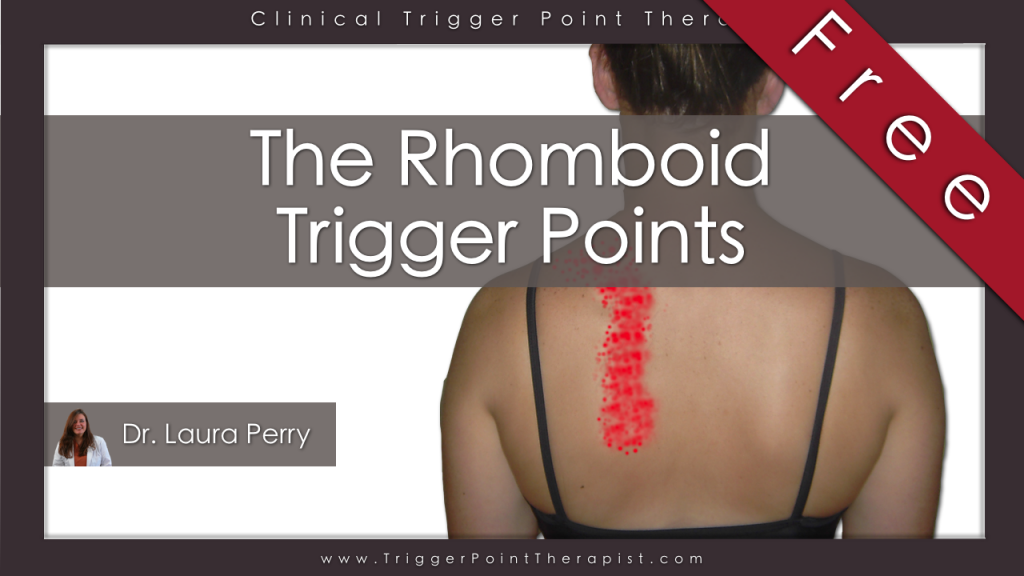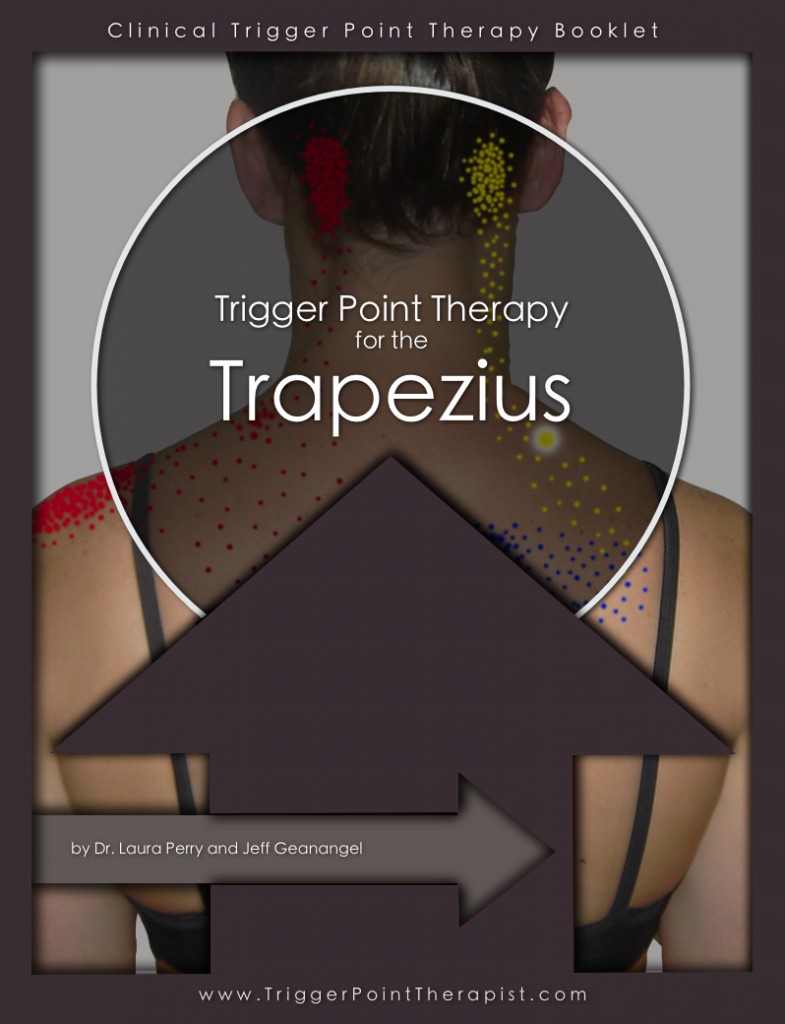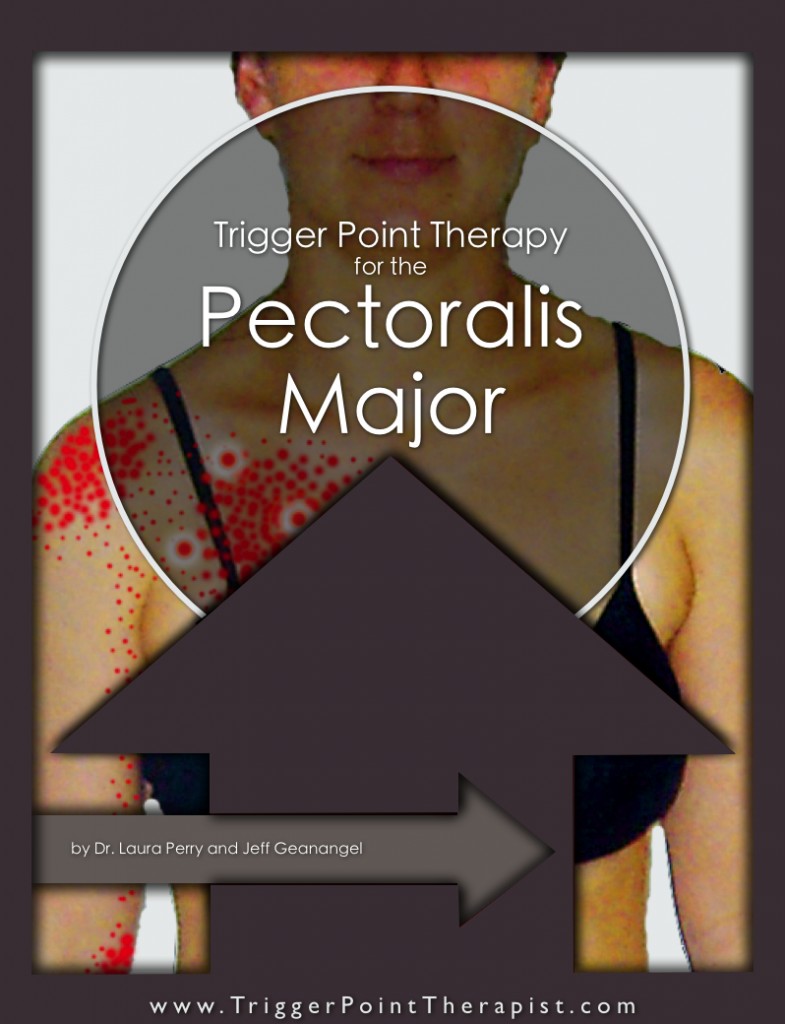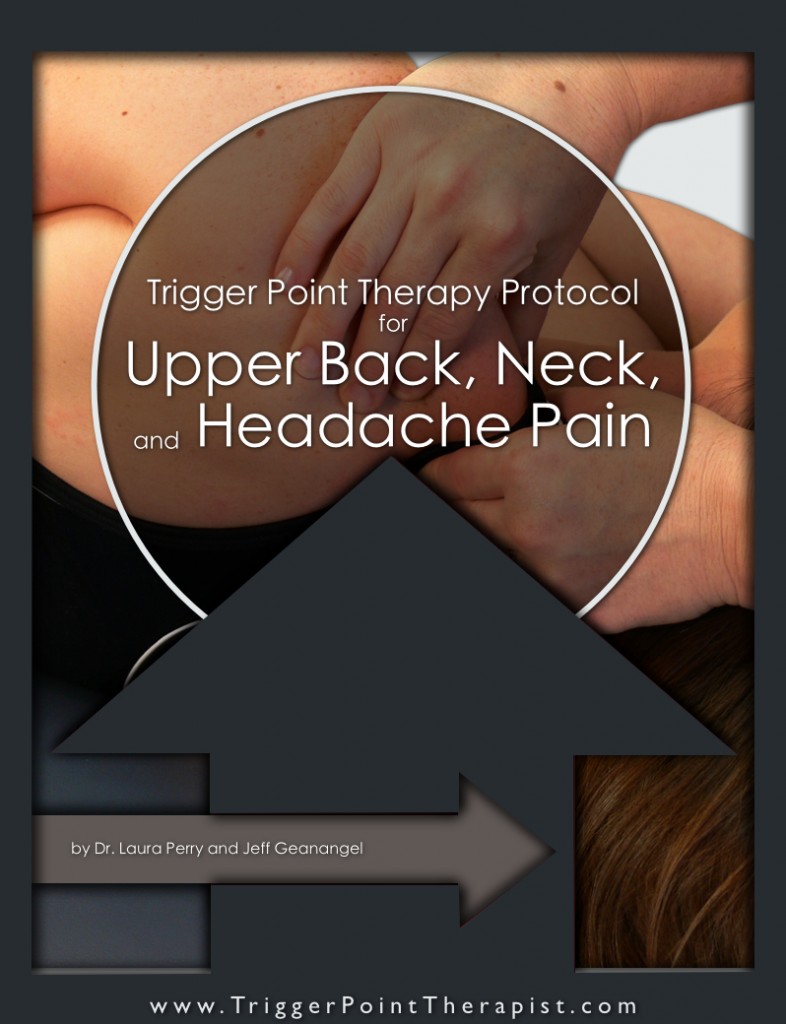That Nagging Pain Between the Shoulder Blades
I have a friend who is a great anatomy teacher. Whenever he teaches about the rhomboid muscles he sticks his chest out and pulls his shoulders back like a cocky young guy strutting his stuff at a night club. It always gets a laugh, but he does this to physically represent the muscular action of the rhomboid muscles.
I’m telling you this because the posture of a person with active rhomboid trigger points will be the exact opposite of that “stud” posture described by my friend. Their chest will be flat, if not concave, and their shoulders will be pulled forward, not back. This is because their rhomboid muscles have been weakened by trigger point activity and can’t do their job.
These people will complain of a nagging pain between their shoulder blades, usually on just one side of their back but sometimes on both sides. Trigger points in several muscles can cause this type of pain but the pain produced by the rhomboid trigger points tends to persist longer than the others.
Often, this rhomboid pain can be a bit perplexing to a trigger point therapist, only showing itself after a successful treatment for another upper back or neck pain complaint. But once you learn about the rhomboid trigger points, they are easier to recognize than that cocky guy strutting his stuff for all to see.
The Rhomboid Muscles
Location: The rhomboid muscle group is found between the spine and the scapula in the mid- back region. It lies deep to the Trapezius muscle and is composed of the rhomboid major and rhomboid minor muscles.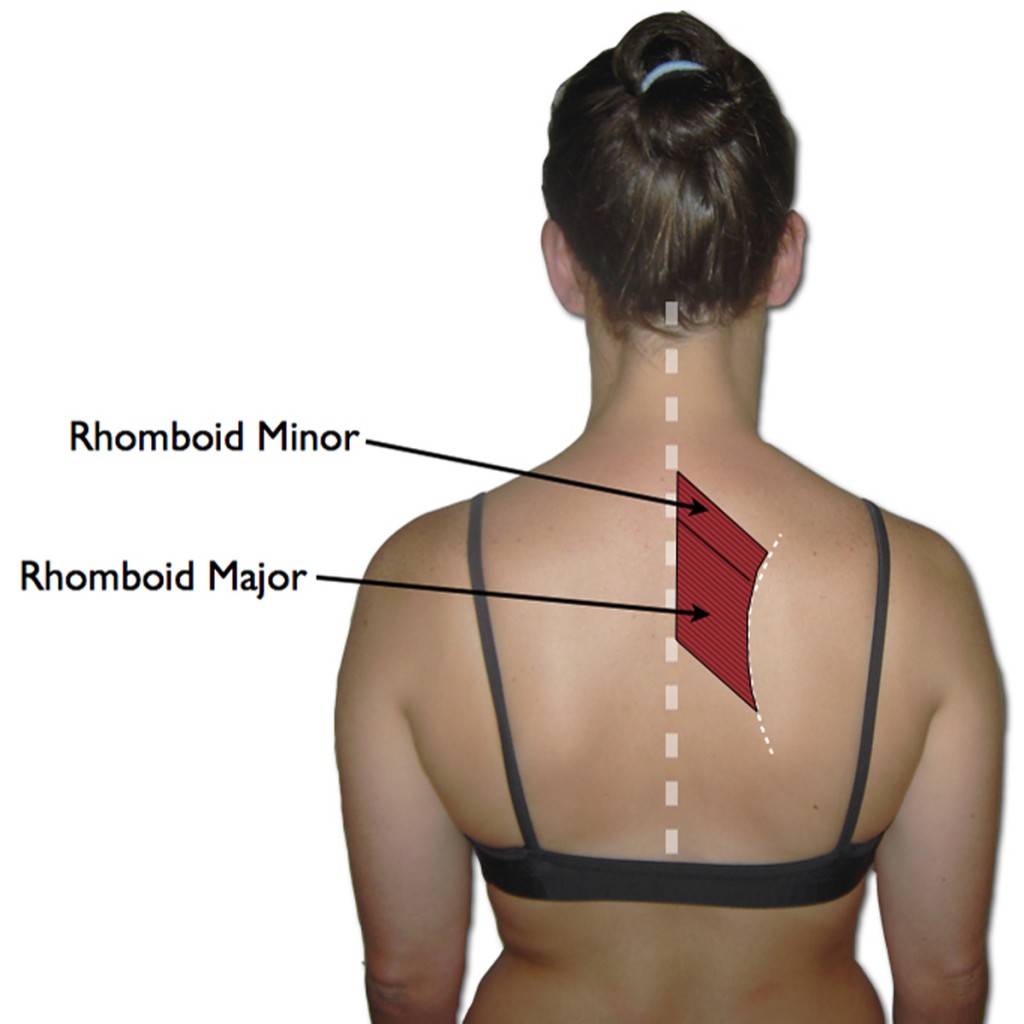
Function: In everyday life, the rhomboid muscles function to position the scapula (a.k.a. the shoulder blade) during various movements of the shoulder and arm.
Muscle Structure: The rhomboid minor is smaller than and lies above (superior to) the rhomboid major. Both muscles originate along the thoracic spine with their fibers running diagonally downward and outward to attach along the inside border of the scapula.
- The rhomboid minor originates on the spinous processes of C7 and T1 and attaches to the medial border of the scapula near the root of scapular spine.
- The rhomboid major originates from the spinous processes of T2 to T5 and attaches along the lower half of the scapular border.
Muscle Actions: Contracting as a whole, the rhomboid muscles pull the shoulder blade towards the spine (scapular adduction). They can also act to elevate the shoulder blade and rotate the shoulder blade so that it lowers the shoulder joint (glenoid fossa).
Biomechanical Considerations: EMG studies of these muscles show the greatest activity when the arm is raised to the side (abduction), though there is also activity when the arm is swinging forward and backward during walking. The rhomboids, along with the other shoulder girdle muscles, act to stabilize or hold the shoulder blade in place while other muscles move the arm at the shoulder joint. Typically, the rhomboid muscles are weakened and inhibited by the rounded-shoulder, sunken chest posture that is so common today.
Synergistic Muscle Groups: The following muscle groups share similar biomechanical functionality with the rhomboids and may become overloaded if they are unable to perform their workload due to trigger point activity or injury:
- The levator scapulae and upper trapezius muscles assist the rhomboids in elevating the shoulder blade.
- The middle trapezius fibers assist the rhomboids during adduction of the shoulder blade (pulling it towards the spine).
- The levator scapula and latissimus dorsi assist with rotation of the scapula.
Antagonistic Muscle Groups: The primary biomechanical antagonists to the rhomboids are the pectoralis major and serratus anterior muscles. Excess muscle tension in the pectoralis muscles is common and will often overload the rhomboid muscles. This relationship allows trigger point activity to spread easily between these muscle groups.
The Rhomboid Trigger Points
Trigger Point Locations: The diagram below shows the three primary trigger points found in this muscle group:
- The rhomboid minor trigger point lies just medial to the inside edge of the scapula, level with the scapular spine.
- The rhomboid major trigger points lie one above the other, along the lower part of the scapular border.
It should be noted that all three of the rhomboid trigger points lie beneath the trapezius muscle and may be difficult to palpate if there is tension or trigger point activity in the trapezius.
Rhomboid Pain & Symptoms
Referred Pain: The diagram above also shows the referred pain pattern associated with the rhomboid trigger points. The pain concentrates in the region between the spine and the shoulder blade. It may also extend to the region above the shoulder blade as well.
The rhomboid and levator scapulae trigger point pain patterns are very similar except that the rhomboid pattern does not involve the neck.
Symptoms & Findings: Clients with active rhomboid trigger points will present with any or all of the following symptoms or clinical findings:
- Pain Between the Shoulder Blades: an aching (but not deep) pain that is felt along the inside of the shoulder blade.
- Pain is usually felt at rest and not typically affected my movement.
- The client may repeatedly reach to rub this area for relief.
- The pain feels superficial (as opposed to the deep pain associated with serratus posterior trigger points).
- Rhomboid trigger point pain is typically masked by the pain from trigger points in the levator scapulae, trapezius, and infraspinatus muscles. It usually becomes apparent only after these other trigger points have been released.
- Client will likely have rounded-shoulder, sunken chest posture where tight pectoralis muscles pull the shoulder forward, producing a chronic strain and stretch on the rhomboids and middle trapezius muscles.
- It is difficult to accurately test the rhomboid muscles for weakness because they have overlapping actions with other muscles in the shoulder girdle.
- Clients may hear snapping or grinding noises from the region around the shoulder blade during movements of the arm.
Activating & Perpetuating Factors: The following events or activities may activate or reactivate the rhomboid trigger points:
- Head-forward, rounded-shoulder, sunken-chest posture as previously described. Sitting in front of a computer for long periods promotes this postural distortion.
- Sleeping on the side can compress the shoulder between the bed and trunk. This compression forces the shoulder blade towards the spine, putting the rhomboid muscle fibers in a shortened state for a prolonged period of time, and predisposing the muscle to developing trigger point activity. Clients should be advised to place a pillow under the arm pit to alleviate the shoulder compression.
- Working with the arms held above the head, such as when painting a ceiling, can overload the rhomboid muscles as they undergo a sustained contraction to stabilize the shoulder girdle.
- Any seated activity that requires one to lean forward for long periods of time, such as writing at a desk or sewing.
Related Disorders: The following disorders should be included in the differential diagnosis of rhomboid trigger point activity
- Thoracic Vertebral Articular Dysfunction: A fixation of the spinal facet joints in the upper thoracic spine may also produce symptoms that are similar to those of rhomboid trigger points. Typically the upper thoracic spine will be unusually flat and not flex forward properly. If you are a chiropractor or osteopath you could adjust T3 to correct this disorder, but a more effective approach is to release the trigger point activity in the thoracic multifidi muscle groups. (See Multifidus Trigger Points: The Chiropractor’s Nemesis for more information)
- Scapulocostal Syndrome: This is another made-up “syndrome” by doctors that have no clue about myofascial trigger points. If a client comes to you with this diagnosis be assured that they have undiagnosed (and untreated) trigger point activity in the trapezius, levator scapulae, scalene, and rhomboid muscles (at least).
Associated Trigger Points: Trigger points in the following muscles may become activated by biomechanical and neurological distortions caused by active rhomboid trigger points (and vice-versa):
- Pectoralis Major: Latent or active trigger points in this muscle can contribute to the rounded-shoulder posture that overloads the rhomboids and middle trapezius muscles.
- Trigger point activity in the scalene, levator scapula, infraspinatus, and trapezius muscles may produce pain that is very similar to that of the the rhomboid trigger points (as well as activate the rhomboid trigger points).
- Rhomboid trigger point referred pain may activate the middle trapezius trigger point.
Rhomboid Trigger Point Treatment
Trigger Point Release Guidelines: I most often see rhomboid trigger points when they pop-up after releasing the trigger points in the trapezius, scalene and levator scapulae muscles. The client will say that they feel much better, but now they have this nagging pain in their mid-back region. They will sometimes try to rub it while on the table. This happened often enough that I now include the rhomboid trigger points in my Upper Back, Neck, and Headache Pain treatment protocol.
The key to releasing these trigger points is making sure that you have released any trapezius trigger points first. If you don’t, you will never be able to accurately locate the rhomboid trigger points by palpation. Even with a relaxed trapezius muscles, these trigger points will feel rather deep to your touch (even though they really aren’t that deep).
If the client can hang their arm off the side of the table, you can work these trigger points with the client in the prone (face down) position. I prefer to have the client in standard side-lying position to allow more forward movement of their shoulder (to stretch the muscle) while I release these trigger points.
Rhomboid Trigger Points Release Procedure
Trigger Point Therapy for Rhomboids Video
Click on the image below to watch the complete Rhomboid Trigger Points video on YouTube for free.
Related Articles:
- Pectoralis Major Trigger Points: The Cardiac Copycats
- Levator Scapulae Trigger Points: Frankenstein Pain
- Trapezius Trigger Points Are Like Opinions…Everybody Has One
Related Instructional Videos:
